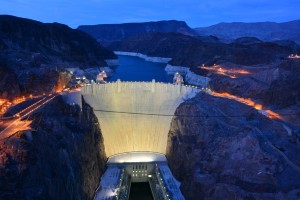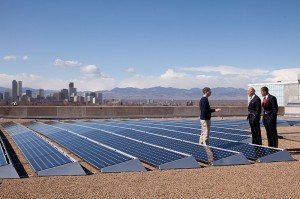587 item(s) were returned.
Dr. Ken Carlson
Colorado State University
Water and energy networks are inextricably linked. Energy production and electricity generation both require water. Conversely, treatment and distribution of water to consumers and wastewater collection and treatment depend on energy. There are multiple other connections between these two fundamental resources and therefore new paradigms are needed for increased usage efficiencies to minimize energy-water conflicts, especially when considering that climate change will significantly impact both. Water has traditionally been abundant in the US, even in drier parts of the country where large, federally funded infrastructure projects have literally made the desert bloom. Energy was also largely readily available so there… [more]
View InsightDirector
Rutgers EcoComplex: New Jersey Agricultural Experiment Station
Industry production systems underlying the Food, Energy, and Water (FEW) Nexus have traditionally treated pollution and waste as externalities that often end up in a landfill. Food waste is the single largest component of municipal solid waste reaching landfills today and is often the byproduct of many FEW Nexus inefficiencies. Inefficiencies that can be addressed through technologies such as anaerobic digesters. In the U.S., food harvesting, processing, and transportation accounts for 10 percent of our energy. However, 40 percent of food goes uneaten and Americans are not only wasting the equivalent of $165 billion each year on this organic compound,… [more]
View InsightSenior Scientist
UFA Ventures, Inc.
After the events of COP21, the National Hydropower Association’s (NHA) goal to expand hydropower in America over the next few decades seems especially important. The existing hydro fleet was constructed over the course of an entire century and constitutes the longest-lived energy facilities in the world. NHA’s goal is to double hydropower by adding 60 GW of capacity by 2030 which will produce an additional 300 billion kWhs of electricity each year, without building a single new dam. Energy Secretary, Ernest Moniz agrees, stating, “Hydropower can double its contributions by the year 2030. We have to pick up the covers… [more]
View InsightAt a recent event hosted by the Hudson Institute, energy professionals gathered to discuss energy issues affecting both the United States and China, with significant discussion centering on how low oil prices generally correlate with economic prosperity and stability – and vice versa. It is projected that China’s oil import dependence will rise from 60% in 2013 to 75% in 2035 and that, in the next 15 years, China will overtake the U.S. as the world’s largest oil consumer. Like the U.S., China’s sustained economic growth is directly influenced by the price of oil. Although crude oil price spikes are… [more]
View InsightThe U.S. currently maintains one of the world’s largest stockpiles of government owned oil, the Strategic Petroleum Reserve (SPR). In response to the 1970s oil embargo and supply shocks, the U.S. created the SPR to ensure access to oil in the event of a severe energy supply interruption. The current SPR consists of four storage sites, housing 694 million barrels of oil that is equivalent to at least 90 days of net oil imports. The SPR has only been tapped three times, but the recent budget deal provides that the government sell 58 million barrels of oil to fund a… [more]
View InsightPresident
Kadak Associates, Inc.
There is an inconvenient and uncomfortable truth that nuclear energy is a significant non-CO2 source of electrical power in the U.S. Despite the dramatic expansion of solar and wind, these alternative forms of energy only provide 15% of non-CO2 emitting power nationwide. Nuclear energy on the other hand, provides 63% of all CO2-free sources. Often when a utility decides to shut down a nuclear plant it is replaced by natural gas. But replacing nuclear with “clean” natural gas only adds to the global CO2 load. In fact, each 1,000 megawatts of nuclear power replaced by natural gas adds 3.6 million… [more]
View InsightThere are over 90,000 cargo ships powered by oil-based fuels that, according to one study, account for 3-4% of worldwide emissions (including SOx, NOx, PM and CO2). In 2012, the International Maritime Organization sparked a series of regulations aimed at reducing sulfur emissions and in January, 2015, a new U.S. rule went into effect that requires ships operating in coastal waters to make further reductions. With an abundance of U.S. natural gas, one potentially cost-effective compliance option is to transition to marine shipping fueled by LNG, however, challenges remain. Supporters of LNG as a fuel source say it will reduce… [more]
View InsightIn 2014, the U.S. residential solar industry installed 1,231 MW of capacity and installation costs fell 10 percent. While lower prices made onsite solar energy more affordable and accessible for many Americans, the upfront costs still make solar installation out of reach to low-income communities that could benefit from alternative sources of energy. Over the past few years, governments at every level have been instituting programs that support low-income access to solar energy. In 2013, California extended two provisions of the California Solar Initiative, the Single-Family Affordable Solar Homes (SASH) and Multi-Family Affordable Solar Homes (MASH) programs, by providing an… [more]
View InsightPartner
KL Gates
Our inability to provide enough skilled labor presents real and serious challenges to our ability to meet America’s energy demands over the coming decades. In recent years there has been a growing and increasingly vast shortage of skilled labor in the energy industry at every professional level, from technical specialists and operators to leaders and senior management. A Deloitte Survey from a few years ago put this in stark perspective with 70% of respondents from throughout the U.S. energy industry answering that given the current labor force, they would not be able to meet their future staffing needs. In addition,… [more]
View InsightPresident
Micro-Utilities, Inc.
Attitudes towards climate change vary. Some have doubts, but even fish know better as they migrate north to cooler waters. Meanwhile, advocates agree that human influence is clear, but they are divided on how to address climate change, with too much focus on individual energy sources when in reality all non-carbon sources of energy have major problems. The divisions amongst advocates can undermine national energy policies and render U.S. policymakers ineffective. But most importantly, divisions amongst advocates rallying for an ‘all-solar,’ ‘all-nuclear,’ or ‘all-anything’ energy system ignore large problems facing a carbon-free future and risk climate change failure. There are… [more]
View Insight








